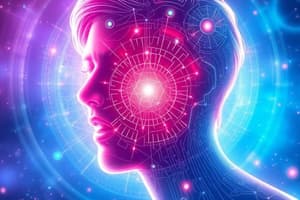Podcast
Questions and Answers
What is another name for speech recognition technology that translates spoken language into written form?
What is another name for speech recognition technology that translates spoken language into written form?
- Language processing
- Vocal conversion
- Voice recognition (correct)
- Talking software
Which company played a significant role in the early days of speech recognition with products like the 'Shoebox' in 1962?
Which company played a significant role in the early days of speech recognition with products like the 'Shoebox' in 1962?
- Apple
- Microsoft
- IBM (correct)
What is the primary goal of speech-to-text conversion?
What is the primary goal of speech-to-text conversion?
- Translate written documents
- Process images into text
- Transcribe spoken language to text (correct)
- Convert text to speech
Which of the following is NOT a common synonym for speech recognition technology?
Which of the following is NOT a common synonym for speech recognition technology?
When did IBM introduce the 'VoiceType Simply Speaking' application related to speech recognition?
When did IBM introduce the 'VoiceType Simply Speaking' application related to speech recognition?
What key role does speech-to-text conversion play in various applications across diverse fields?
What key role does speech-to-text conversion play in various applications across diverse fields?
Which industry uses speech recognition technology to improve driver safety?
Which industry uses speech recognition technology to improve driver safety?
What is the primary metric used to measure the accuracy of speech recognition systems?
What is the primary metric used to measure the accuracy of speech recognition systems?
Which of the following factors can affect the word error rate in speech recognition?
Which of the following factors can affect the word error rate in speech recognition?
What is the goal in speech recognition technology that has long been a target?
What is the goal in speech recognition technology that has long been a target?
Which application of speech recognition technology is used to assist with common customer queries and reduce the need for contact center agents?
Which application of speech recognition technology is used to assist with common customer queries and reduce the need for contact center agents?
What is the projected market size for speech recognition technology by 2025?
What is the projected market size for speech recognition technology by 2025?
Flashcards are hidden until you start studying
Study Notes
Speech Recognition: Overview and Focus on Speech-to-Text Conversion
Introduction
Speech recognition, often referred to as speech-to-text conversion or voice recognition, is a technology that translates spoken language into written form. This article provides an overview of speech recognition, emphasizing the subtopic of speech-to-text conversion, which plays a critical role in various applications across diverse fields.
What is Speech Recognition?
Speech recognition is a computer-based technology that allows machines to process and interpret human speech, converting it into written text or other output formats. It is also known as automatic speech recognition (ASR) or computer speech recognition. The primary goal of speech recognition is to accurately transcribe spoken language, making it possible for computers to understand and respond to human speech.
History of Speech Recognition
The history of speech recognition can be traced back to the 1950s, with early work conducted at Bell Labs. IBM has been a prominent player in this field, starting with the "Shoebox" in 1962 and continuing to innovate over the years with products like the VoiceType Simply Speaking application in 1996.
Speech-to-Text Conversion
Speech-to-text conversion is a specific application of speech recognition technology. It involves transcribing spoken language into written text, making it easier to process and analyze. This process is crucial in various industries, including:
- Automotive: Voice-activated navigation systems and search capabilities in cars improve driver safety.
- Technology: Virtual agents on mobile devices and speakers, such as Google Assistant or Amazon's Alexa, facilitate voice search and music playback.
- Healthcare: Doctors and nurses use dictation applications to capture and log patient diagnoses and treatment notes.
Techniques and Performance
Speech recognition techniques vary, including acoustic models, pronunciation dictionaries, and language models. Current state-of-the-art systems focus on improving accuracy rates, typically measured by word error rate (WER).
Factors Influencing Accuracy
There are several factors that can affect the word error rate in speech recognition, such as pronunciation, accent, pitch, volume, and background noise. Reaching human parity (WER equal to that of two humans speaking) has long been a goal in speech recognition.
Applications of Speech Recognition
Speech recognition technology is widely adopted across numerous industries and applications, such as:
- Automotive: Improve driver safety by enabling voice-activated navigation systems and search capabilities in cars.
- Technology: Virtual agents integrated into mobile devices and speakers facilitate voice search and music playback.
- Healthcare: Doctors and nurses use dictation applications to capture and log patient diagnoses and treatment notes.
- Security: Voice-based authentication adds a layer of security to convert speech into text using AI-powered speech recognition.
- Consumer Issues: AI chatbots can assist with common queries and solve basic requests without requiring contact center agents to be available, reducing time to resolution for customer inquiries.
Adoption and Market Growth
Speech recognition technology has seen significant growth and is expected to remain a key area of investment and development. The market is projected to reach USD 24.9 billion by 2025.
In conclusion, speech recognition, specifically speech-to-text conversion, plays a crucial role in facilitating communication between humans and computers, enhancing productivity and efficiency across various sectors. With ongoing advancements in AI and machine learning, speech recognition technology will continue to shape our interactions with devices and services in the future.
Studying That Suits You
Use AI to generate personalized quizzes and flashcards to suit your learning preferences.




